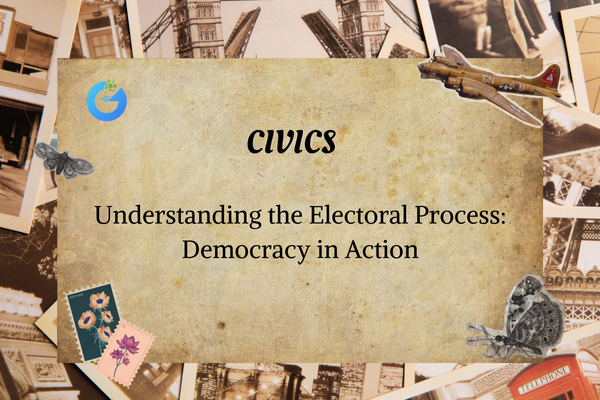Introduction
Have you ever watched people standing in long queues outside schools or community halls with inked fingers and wondered why they do it?
That simple act of voting is the heartbeat of any democracy. It’s not just about choosing leaders—it’s about shaping the nation’s future. Every vote counts. Every voter matters.
To truly value our rights as citizens, we must first understand how elections work. The electoral process in India is designed to be fair, transparent, and inclusive—giving every adult the power to participate in governance.
expert-led Civics classes – visit our website to learn more
What Is the Electoral Process?
The electoral process is a set of steps that allows citizens to elect representatives through voting. It is one of the most vital tools that upholds democracy.
In simple terms, it ensures:
- People choose their own leaders
- Power is transferred peacefully
- Every citizen has a say in how the country is run
Step-by-Step Breakdown of the Electoral Process
Let’s understand what happens before, during, and after elections:
1. Voter Registration
- All citizens who turn 18 can register to vote.
- Names are added to the Electoral Roll, a list of eligible voters.
- A Voter ID card is issued by the Election Commission.
2. Announcement of Elections
- The Election Commission of India (ECI) announces election dates and schedules.
- The Model Code of Conduct comes into effect, ensuring fair campaigning by all parties.
3. Filing of Nominations
- Candidates from political parties or independents file papers to contest elections.
- Their backgrounds, criminal records (if any), and assets are reviewed.
4. Election Campaigning
- Political parties reach out to people through speeches, posters, social media, and rallies.
- They share their promises (called manifestos) and request votes.
- Hate speech, bribery, and false promises are strictly prohibited.
5. Polling Day
- Voters go to polling booths to cast their vote using Electronic Voting Machines (EVMs).
- The vote is secret, and each voter can vote only once.
6. Vote Counting and Results
- After polls close, votes are counted under tight security.
The Role of the Election Commission
The Election Commission of India (ECI) is an independent authority that conducts elections.
Key Functions:
- Organizing elections at national, state, and local levels
- Enforcing the Model Code of Conduct
- Ensuring fair use of money and media in campaigns
- Monitoring voter turnout and addressing complaints
- Using technology for transparency
The ECI acts as the watchdog of democracy, making sure the process stays clean and free from bias.
Rights and Responsibilities of a Voter
Being a voter is both a right and a responsibility.
Your Rights:
- Vote without fear, pressure, or discrimination
- Know your candidates and their backgrounds
- Use the NOTA (None of the Above) option if dissatisfied
Your Responsibilities:
- Register on time and carry valid ID to vote
- Stay informed about issues and party manifestos
- Avoid selling your vote or voting under influence
A wise voter chooses leaders based on merit—not on religion, caste, or false promises.
Types of Elections in India
India is a federal democracy. This means elections happen at different levels.
1. Lok Sabha Elections (Every 5 years)
- Elects members to the Parliament of India
- Forms the central government
2. State Assembly Elections
- Elects MLAs (Members of Legislative Assembly)
- Forms the state government
3. Panchayat and Municipal Elections
- Held in villages and towns
- Citizens elect members for local governance
4. Rajya Sabha Elections
- Members are elected indirectly by state legislators
Technology in Elections
Modern technology has improved the voting process:
- Electronic Voting Machines (EVMs): Fast and tamper-proof voting
- VVPAT (Voter Verified Paper Audit Trail): Shows a paper slip to verify your vote
- Apps and Portals: For voter registration, candidate info, and complaints
- Live CCTV monitoring: At polling stations for transparency
Why Electoral Awareness Matters
Many people don’t realize how important their vote is. Lack of awareness leads to:
- Low voter turnout
- Easy misuse of money or fake promises
- Poor leadership choices
Educated and aware voters:
- Ask questions
- Demand accountability
- Make informed decisions
Voting isn’t just a right—it’s your voice in building the nation.
Core Concepts Table
| Term | Meaning |
| Electoral Process | Steps followed to conduct elections |
| Voter ID | Card issued for voting eligibility |
| EVM | Machine used to record votes electronically |
| VVPAT | Paper trail confirming the vote cast |
| Model Code of Conduct | Rules for fair campaigning |
| NOTA | Option to reject all candidates |
| Election Commission | Authority that oversees elections in India |
Frequently Asked Questions
Q1. What is the minimum age to vote in India?
18 years.
Q2. What does NOTA mean?
“None of the Above”—used when you don’t support any candidate.
Q3. Can one vote more than once?
No. It’s a criminal offense.
Q4. What if someone’s name is missing from the voter list?
They must apply to get their name added through official channels.
Q5. Who oversees free and fair elections?
The Election Commission of India.
Fun Facts
- India is home to the largest democracy in the world.
- The 2019 General Election had over 900 million registered voters.
- EVMs replaced paper ballots in India in 1999.
- The first Indian general election was held in 1951–52.
- Election officials once traveled by elephant, camel, and boat to reach remote voters.
Conclusion
The electoral process is more than a system—it is the spirit of democracy in action. Every step, from voter registration to result declaration, ensures that power lies with the people.
By understanding how elections work, we learn that change doesn’t come only from leaders. It comes from us—the voters. Participating in the electoral process means we’re not just watching history—we’re helping write it.








